Moving Your IBM Content Manager OnDemand (CMOD) System to the Cloud
Did you know that 67% of enterprise infrastructure is estimated to be cloud based by the end of 2020? (Source: Forbes). Five years ago, many organizations weren’t sure if they wanted to move to the cloud. Two years ago there was a lot more interest, but management wasn’t yet on board. Today nearly every organization has a cloud directive, and the recent COVID-19 crisis has accelerated the need to adopt.
One of the hottest topics of discussion today for legacy customers evolves around moving their mission critical Content Manager OnDemand (CMOD) system to the cloud.

Why Move IBM CMOD to the Cloud?
- Lower Costs: Drive down operational costs and use funds on more strategic investments in technology.
- Improve Responsiveness: Provide IT greater agility to meet the business needs by providing a faster time to market.
- Internal resources can focus on strategic initiatives: Allow internal resources to focus on strategic initiatives that are critical to the success of the business.
COVID-19 has forced organizations to quickly adapt, and with employees working from home they are not always able to accomplish the work that needs to get done. A managed public cloud offers the perfect solution – it can both host and manage your environments for you. A few benefits of public cloud hosting include:
Security
From the console you can determine who and what will have access to your infrastructure. You are able to add security components to ensure that you're meeting your security and your compliance needs. Configuring the services you want to use is inexpensive compared to the cost of implementing services in your own data center or on-premise (and with most public cloud vendors there are also marketplaces that allow you to use third party tools or utilities). Lastly, there are many options available to help track and maintain specific compliance or regulatory compliance, including monitoring and logging.
Flexibility
In the cloud you have the ability to scale up and scale down as needed. You can create templates to deploy new servers or new environments – it's not necessary to wait for weeks (or even months) to get the additional features that you might need to work with your infrastructure. Public cloud vendors are also adding new features constantly.
Reliability
Public cloud data centers have redundancies already in place. Server uptime is rated at four nines (99.99), five nines (99.999) availability on storage, and 11 nines (99.999999999) of durability for some storage options. Building in additional redundancies, such as additional servers, databases, and storage, will increase the up-time and availability.
Business Continuity
You can schedule your snapshots or backups as often as you want and store them both locally as well as in other data centers. For disaster recovery you can select the best option available based on the RTO and RPO that you need. We have developed a low-cost DR method that allows for sub second RPO and mere minutes in RTO capabilities for your CMOD applications. There are also many well-known vendors in the marketplace that you can simply add on to your current infrastructure.

What to Consider Before Moving IBM CMOD to the Cloud
Licensing
Take a look at the licenses that you already own, as you can often bring those to the cloud. This is called BYOL or bring your own license. In many cases you can leverage out-of-the-box licenses that are bundled with your IBM product. Your CMOD licensing is configured as either external users, employees, authorized users, or Processor Value Unit (or PVU). You can continue to use these in a public cloud as well.
PVU licensing determines how many CPU resources you are able to utilize with CMOD. Since your applications in the cloud are easy to scale, you are able to quickly increase the CPUs or add additional servers. You just have to watch to be sure you don't exceed what you're licensed for from a PVC perspective.
Cloud Infrastructure
When moving into the cloud you need to work with your IT team to find out what they are most familiar with supporting, especially concerning the operating system and the database. If your IT team has moved away from that underlying infrastructure that your CMOD environment was originally set-up on, now might be a good time to switch to something they are able to more easily support. While there's definitely more work involved, it would likely be easier to perform as you are moving to the cloud.
Migration
If you have a lot of data, each of the public cloud vendors have ways to help you get it to them. Terabytes and even petabytes of data can be transferred to public cloud vendors pretty quickly. For example, AWS has a device (snowball) that can handle large volumes of storage. They send you the device, you download your data and send it back. They will then upload it into the data center for you. Many public cloud vendors also offer database migrations and have tools that will allow you to sync your database from on-prem to the public cloud
Upgrades
IBM has moved support to a continuous delivery model, releasing new feature packs every three to six months. Usually they only offer the security and defect support fixes for the two most recent revisions of that software, and support is good for about one year for each version. They also have Long Term Support Releases (LTSR) versions, which will have support for at least 2 years.
Now is the perfect time to upgrade your Content Manager OnDemand (CMOD) system. This allows you to leverage the latest versions of the CMOD software and the underlying operating system so you can get the latest and greatest of any components that you're using (and you don't have to worry about updating too soon down the road).
Because of the faster release schedule, you will want to begin your planning and preparing to upgrade every two years.
Managed Services Provider
When you have a dedicated team administering the solution they're solely focused on, it will always be a better model. However, most organizations do not have the luxury of dedicated resources, and that's where Managed Services comes in. In one sentence, Managed Services is a comprehensive end-to-end remote support administration for your IBM Content Manager OnDemand (CMOD) system, offering a single point-of-contact (SPOC) for all issues.
About enChoice
Founded in 1993, enChoice has been providing mission-critical support to ECM systems, including IBM Content Manager OnDemand (CMOD), for over 25 years. An award-winning Enterprise Content Management (ECM) and Digital Transformation solutions company, enChoice software, services, and support help customers accelerate their digital transformation by leveraging content and optimizing business processes.
With a dedicated US-based staff of engineers providing Mission Critical Support 24X7X365, the enChoice team knows the ins and outs of the (CMOD) Content Manager OnDemand system including how it can be tuned, monitored and updated. We have adopted a philosophy of hiring very experienced and deeply skilled people - our average experience base in our team is over 15 years. Every one of our accounts has a defined primary and secondary support engineer, and their mission is to know you and know your system(s). Since 2003, we have averaged a 9.5/10 customer satisfaction rating.
enChoice is an IBM Gold Business Partner and IBM 2015 Business Partner of the Year. Discover why over 1,000 leading companies have chosen enChoice as their trusted digital transformation expert.
To learn more, visit: www.enChoice.com.
About the Author
 |
|
Robert Short is the Director of Cloud Services at enChoice, and resident Subject Matter Expert surrounding the cloud. Robert began working with Enterprise Content Management at FileNet in 1997. He joined IBM in 2006 when they purchased FileNet and was responsible for the development of the installation and upgrade best practices. He left IBM to join Adjacent Technologies in 2013, becoming the Director of the Cloud Services organization which was responsible for hosting many customers in different public cloud spaces. Adjacent Technologies was acquired by enChoice in 2019.
|
Click here for more information or to schedule a 1:1 ask the expert session.